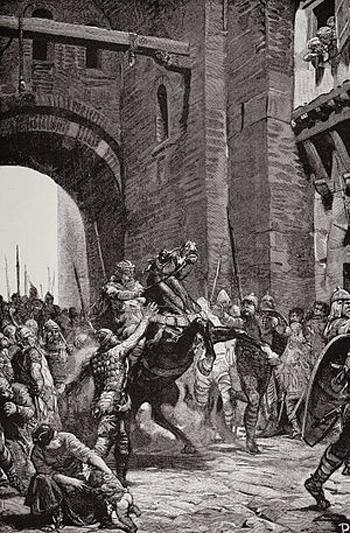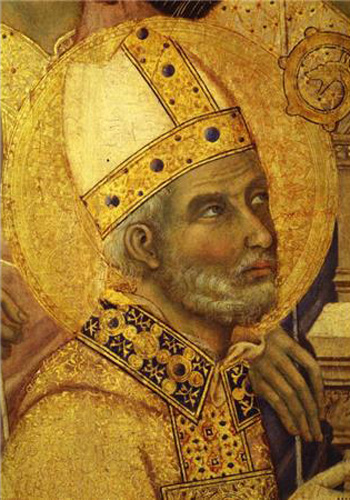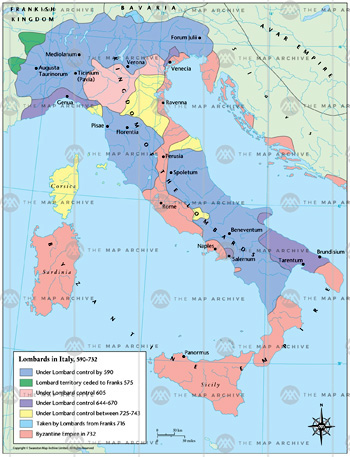Stories & Legends
 |
 |
 |
 |
 |
 |
 |
Miracles in the Crusades - 5
St. Sabinus Fights alongside the Lombard King
The Crusader Normans of the South were keenly aware of the intervention of God in their history in their past. The appearance of Saints to fight alongside them at
the Battle of Antioch was not the first time such a miracle had occurred in their history.
 In his Historia Langobardorum, Paul the Deacon wrote of the deeds of the Lombards and how they invaded and conquered much of Italy. Paul the Deacon describes St. Sabinus, a 6th century Bishop of Bari and a friend of St. Benedict, as intervening in the Battle of Camerino, fought in the late 6th century between the Lombard Duke Ariulf of Spoleto and the Byzantines.
In his Historia Langobardorum, Paul the Deacon wrote of the deeds of the Lombards and how they invaded and conquered much of Italy. Paul the Deacon describes St. Sabinus, a 6th century Bishop of Bari and a friend of St. Benedict, as intervening in the Battle of Camerino, fought in the late 6th century between the Lombard Duke Ariulf of Spoleto and the Byzantines.
There has never been reason to doubt the word of this author who wrote of the battles of laymen, recorded by History to be a "man distinguished in life, knowledge and doctrine." (1)
The history is interesting and worth recounting in this Crusade series as it offers one of the first instances in the West of a Saint appearing to intervene in a pitched battle.
The Lombards, known as Longbeards, were a Germanic tribe that originated in Scandinavia and had migrated to the region of Pannonia (modern day Hungary). In 568 they left Pannonia en masse and invaded Italy.
Duke Ariulf & the mysterious warrior
In the 590s Duke Ariulf of Spoleto, a town on the way from Ravenna to Rome, was waging war against the Byzantines at Camerino and gained the victory. Afterwards, he began to ask his men for the name of the man whom he had seen fighting with such courage in the war he had waged.
The men answered that they had not seen anyone there acting more bravely than the Duke himself, who was famous for his daring feats.
"Nay," he replied, "Surely I saw another man there who was much and in every way better than I. And, as often as anyone attempted to strike me, that goodly man always protected me with his shield." But no one else had seen that men.
Shortly afterwards, the Duke came to Spoleto where the body of the blessed martyr, the Bishop St. Sabinus, reposes. Ariulf asked to whom belonged this spacious abode.
 Some devout men told him that the martyr Sabinus reposed there whom Christians were wont to invoke to their aid when they went to war against their enemies.
Some devout men told him that the martyr Sabinus reposed there whom Christians were wont to invoke to their aid when they went to war against their enemies.
Ariulf, since up to this time he was a heathen, asked: "And can it be that a dead man can give any aid to one living?"
And, after saying this, he leaped down from his horse and went into the church to look at it. And while the others were praying, he began to admire the pictures of that church. And when he had beheld the painted figure of the blessed martyr Sabinus, he straightway said and declared with an oath that this was the very man who had protected him in battle, for in every way he had such a form and bearing.
Then it was understood that the blessed martyr Sabinus had brought him help in battle.
The Lombard chief converted to Roman Christianity as a result. The Lombards always saw this episode as a sign of God's assistance in establishing the Lombardy Kingdom, which was set up under their King Alboin in 560.
Their Kingdom grew in size and strength until it comprised almost the whole of modern day Italy. It lasted until 774 when they were defeated by the Franks and afterwards their name still survives in the modern-day region of Lombardy in northern Italy.

Continued
Adapted from History of the Langobards by Paul the Deacon,
trans. by W.D. Fouke, LL.D., New York: Longmans, Green & Co., 1907, pp. 155-163
Posted September 21, 2019

Alboin, King of the Lombards, entering a city in Italy
There has never been reason to doubt the word of this author who wrote of the battles of laymen, recorded by History to be a "man distinguished in life, knowledge and doctrine." (1)
The history is interesting and worth recounting in this Crusade series as it offers one of the first instances in the West of a Saint appearing to intervene in a pitched battle.
The Lombards, known as Longbeards, were a Germanic tribe that originated in Scandinavia and had migrated to the region of Pannonia (modern day Hungary). In 568 they left Pannonia en masse and invaded Italy.
Duke Ariulf & the mysterious warrior
In the 590s Duke Ariulf of Spoleto, a town on the way from Ravenna to Rome, was waging war against the Byzantines at Camerino and gained the victory. Afterwards, he began to ask his men for the name of the man whom he had seen fighting with such courage in the war he had waged.
The men answered that they had not seen anyone there acting more bravely than the Duke himself, who was famous for his daring feats.
"Nay," he replied, "Surely I saw another man there who was much and in every way better than I. And, as often as anyone attempted to strike me, that goodly man always protected me with his shield." But no one else had seen that men.
Shortly afterwards, the Duke came to Spoleto where the body of the blessed martyr, the Bishop St. Sabinus, reposes. Ariulf asked to whom belonged this spacious abode.

Saint Sabinus, martyred by Diocletian c. 300 AD
Ariulf, since up to this time he was a heathen, asked: "And can it be that a dead man can give any aid to one living?"
And, after saying this, he leaped down from his horse and went into the church to look at it. And while the others were praying, he began to admire the pictures of that church. And when he had beheld the painted figure of the blessed martyr Sabinus, he straightway said and declared with an oath that this was the very man who had protected him in battle, for in every way he had such a form and bearing.
Then it was understood that the blessed martyr Sabinus had brought him help in battle.
The Lombard chief converted to Roman Christianity as a result. The Lombards always saw this episode as a sign of God's assistance in establishing the Lombardy Kingdom, which was set up under their King Alboin in 560.
Their Kingdom grew in size and strength until it comprised almost the whole of modern day Italy. It lasted until 774 when they were defeated by the Franks and afterwards their name still survives in the modern-day region of Lombardy in northern Italy.

From the 6th to the end of the 7th century
the Lombards conquered much of Italy
Continued
Adapted from History of the Langobards by Paul the Deacon,
trans. by W.D. Fouke, LL.D., New York: Longmans, Green & Co., 1907, pp. 155-163
Posted September 21, 2019


